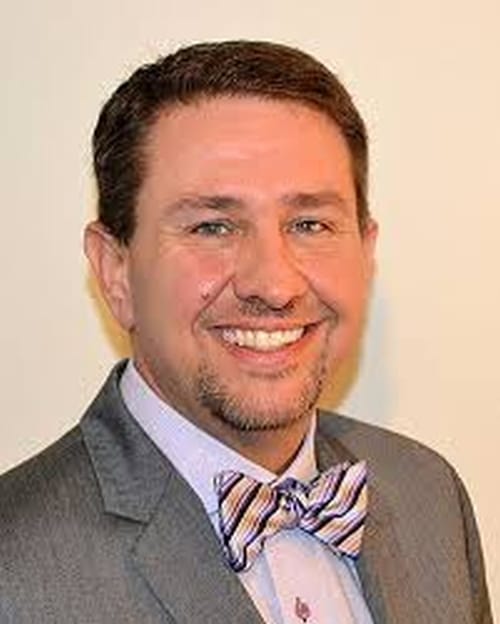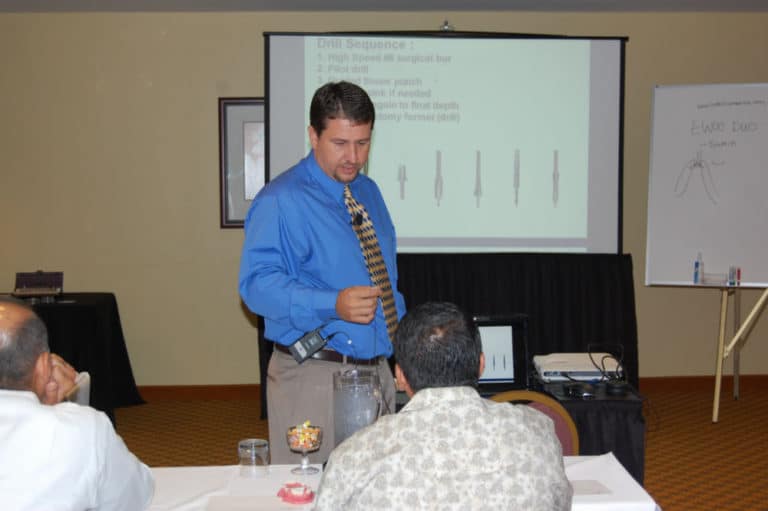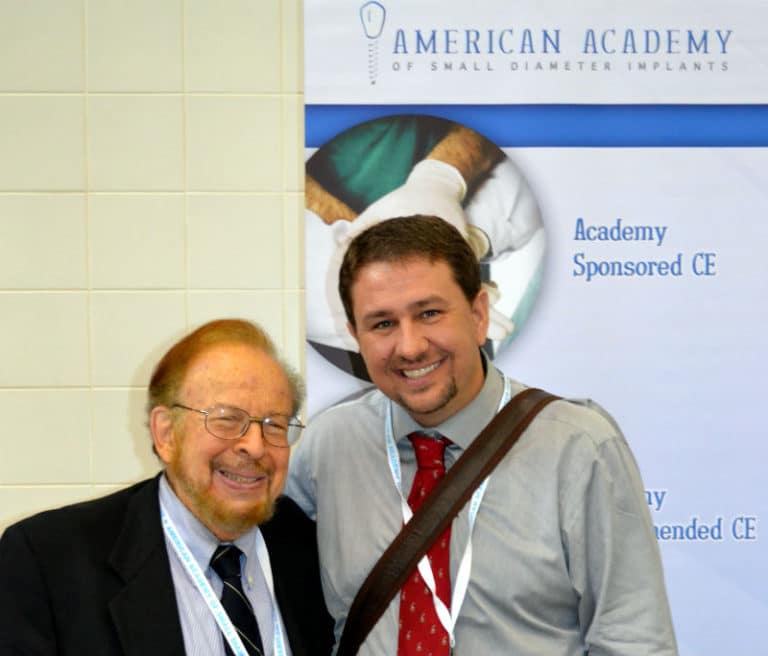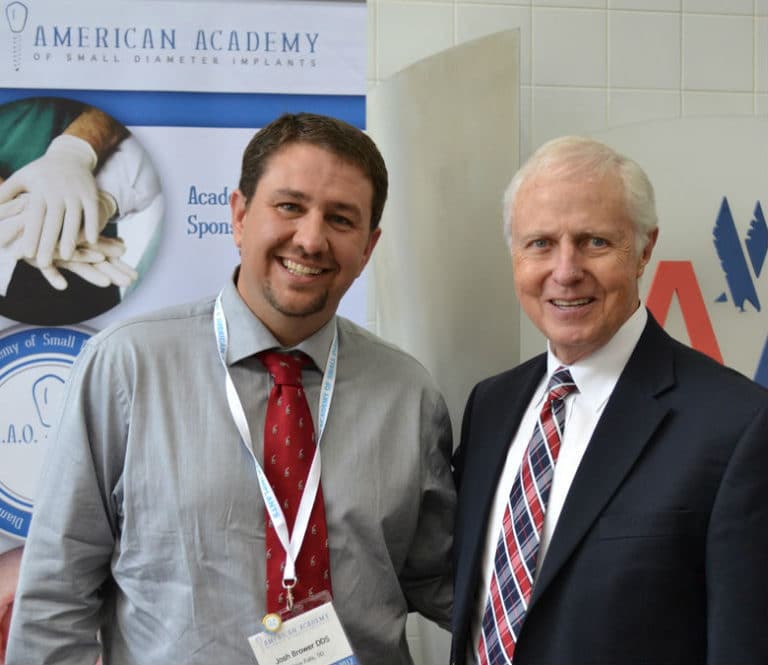Dr. Brower began restoring and placing implants in 1997 and continues to be heavily involved in the forefront of implant therapy in the U.S. He has placed and restored over 8,000 dental implants since 1997 and helped develop two independent dental implant lines for manufacturers. He teaches live surgery courses in his offices with doctors coming from all over the world to see him perform live surgery multiple times per year.
Dr. Brower can also be seen at the University of South Dakota Chemistry department website giving a lecture on organic chemistry where he helps develop new kinds of dental products to help prevent and restore cavities.
He has lectured and taught dental implantology internationally and been a keynote speaker at the University of California San Diego where he was filmed for international training of other dentists. His implant videos can be see on the dentinal tubules network which is the largest depository of dental knowledge on the planet.
Dr. Brower is faculty for the International Academy of Dental Implants and a featured keynote speaker in China where implant dentistry is fast becoming something every dental practitioner there performs.
He also teaches orthodontics (braces) and publishes/lectures for the American Orthodontic Society. He runs dental forums for orthodontics and dental implants and moderates the conversations of hundreds of dentists every day.
He is an American Dental Association accredited and approved continuing education lecturer, and has continuing education available through www.dentaltown.com which is the worlds largest gathering of dentists on the current state of implant prosthetics in the 21st century.
He is licensed in South Dakota, Nebraska, California, and maintains an active sedation permit in South Dakota. All of his licenses and permits have always been and continue to be in good standing. Dr. Brower has performed legal defense of dentists who place dental implants on multiple occasions and is available for expert opinions.
He also maintains active membership in the South Dakota Dental Association, American Dental Association, International Association of Orthodontics, American Orthodontic’s Society, and is a founding member of the American Academy of Small Diameter Implants where he holds Mastership status and the International Academy of Mini Dental Implants where he holds Mastership status. He is also a Diplomate of the International Academy of Dental Implants and course teacher. Dr. Brower has 4 children.
Dental Implant
The Dental Implant Procedure
Today’s dental implants are virtually indistinguishable from other teeth. This appearance is aided in part by the structural and functional connection between the dental implant and the living bone. Implants are typically placed in a single sitting but require a period of osseointegration.
Osseointegration is the process by which direct anchorage of a dental implant root and the bone of the jaw occurs. Osseointegrated implants are the most commonly used and successful type of dental implant. An osseointegrated implant takes anywhere from three to six months to anchor and heal, at which point your dentist can complete the procedure with the placement of a crown. Once the implant has anchored with the jawbone, artificial prosthesis may be attached and the process is done. If osseointegration does not occur, the implant will fail.
Detailed procedural steps are as follows:
Preparing the Jaw for Implantation: A dental implant is commonly composed of a titanium material screw and a crown. A small-diameter hole (pilot hole) is drilled at edentulous (where there is no tooth) jaw sites in order to guide the titanium screw that holds a dental implant in place. To avoid damaging vital jaw and face structures like the inferior alveolar nerve in the mandible (lower jaw), a dentist must use great skill and expertise when boring the pilot hole and sizing the jaw bone.
Placement of the Implant: After the initial pilot hole has been drilled into the appropriate jaw site, it is slowly widened to allow for placement of the implant screw. Following this placement, a protective cover screw is placed on top to allow the implant site to heal and the dental implant to anchor (osseointegration). After several months, the protective cover is removed and a temporary crown is placed on top of the dental implant. The temporary crown serves as a template around which the gum grows and shapes itself in a natural way. The process is completed when the temporary crown is replaced with a permanent crown.
Success Rates of Dental Implants
Dental implants are among the most successful procedures in dentistry. There is no guarantee that an implant procedure will be successful, but studies have shown a five-year success rate of 95% for lower jaw implants and 90% for upper jaw implants. The success rate for upper jaw implants is slightly lower because the upper jaw (especially the posterior section) is less dense than the lower jaw, making successful implantation and osseointegration potentially more difficult to achieve. Lower posterior implantation has the highest success rate for all dental implants.
Dental implants may fail for a number of reasons. The cause is often related to a failure in the osseointegration process. For example, if the implant is placed in a poor position, osseointegration may not take place. Dental implants may break or become infected (like natural teeth) and crowns may become loose.
If you are a smoker who is considering a dental implant, your dentist will likely advise you to give up smoking before undergoing the process because smokers face a higher risk of implant failure. Since the procedure can be extremely expensive, you risk wasting your money on dental implants if you do not give up the habit.
On the plus side, dental implants are not susceptible to the formation of cavities; still, poor oral hygiene can lead to the development of peri-implantitis around dental implants. This disease is tantamount to the development of periodontitis (severe gum disease) around a natural tooth.
Why are yours so affordable? What is the cost of dental implants? Why choose you when many people offer implants?
Every surgeon may set their own individual fees for a particular procedure. The cost of the implants from the manufacturers to the practitioner is the same for a single implant, but when buying large quantities of implants they significantly reduce the cost of the implants to the practitioner. We have a significantly reduced fee for our implants of under $1000 to a maximum of $1550 for implants for crowns per implant compared to a traditional fee which is much higher because we are purchasing implants in larger volumes to keep up with the number we place. As general dentists we also create the crown or cap that will go on top of the implant and the fee associated with that helps offset the reduced cost we charge for the implants. Simply put, we are passing on the savings to you by doing a larger volume and keeping the work in house. When a patient is referred out to a “specialist”, the specialist traditionally will have to order in the particular brand and size of implant that will be adequate for the site of the patient that is presented to them. It is impossible for them to know what will be presented to them in advance, so it would be very cost prohibitive to stock every brand and size of implant “in case” that patient arrived. Most have a set brand and certain sizes on hand, but as a specialist they traditionally will get the unusual cases or very difficult cases that do not lend themselves to normal situations. Fortunately what we have found in our clinic is that over 95% of implant placement is in normal locations in normal situations that do not require extreme bone grafting, specialized implants, or specialized placements. Placement and restoration is as routine as getting a filling in 95% of the cases for us!
Our denture package is $7500 and very popular. It provides a discount for tooth removals that limit the fee to $100 each, and a discount for bone grafting each of the tooth removals to $100 each. This includes a provisional immediate denture and the dental implants needed to support the denture which are usually placed at the same time. Future dentures and prosthetics are sometimes needed since these are immediate dentures and are not included. You may also choose to have “No More Dentures” and go to a hybrid appliance made out of PMMA or Porcelain which we remove for you at your 3 month cleanings which we want you to schedule with us so we can continue to monitor the health of the implants and prosthetics.







 During his studies there he accepted a Health Professional Scholarship from the United States Army where he received advanced training at Tripler Army Medical Center from 1995-1997 on Oahu over a period of 2 years. He specifically worked side by side with a gifted team of oral surgeons and an orthodontist that ran the US Army residency training program. After 4 years he graduated from the University of Minnesota with Honors, and in 1997 accepted an officers commision in the Army where he requested his initial duty station to be in Germany. He was granted his wish and was again allowed to train with a group or oral surgeons, orthodontist, and a board certified prosthodontist. He continued his advanced training for 2 years in Germany and then moved back to the US where he worked in a clinic in Lousiana with 26 other dentists. Upon completion of his military tour and honorable discharge Dr. Brower moved to the midwest with his wife Peggy and their family to pursue larger family and settle down into private practice. Dr. Brower’s advanced training allows him to perform many procedures that other general dentists have not received the training to perform in office which gives patients great comfort when considering being “referred out” when something needs to be done. By allowing one practitioner to see all aspects of the same case and not having each piece looked at by someone different over a wide range of times amazing results can be achieved. In no other way can multiple specialty procedures be combined into one appointment as you can see from the photos of our wonderful patients on the site.
During his studies there he accepted a Health Professional Scholarship from the United States Army where he received advanced training at Tripler Army Medical Center from 1995-1997 on Oahu over a period of 2 years. He specifically worked side by side with a gifted team of oral surgeons and an orthodontist that ran the US Army residency training program. After 4 years he graduated from the University of Minnesota with Honors, and in 1997 accepted an officers commision in the Army where he requested his initial duty station to be in Germany. He was granted his wish and was again allowed to train with a group or oral surgeons, orthodontist, and a board certified prosthodontist. He continued his advanced training for 2 years in Germany and then moved back to the US where he worked in a clinic in Lousiana with 26 other dentists. Upon completion of his military tour and honorable discharge Dr. Brower moved to the midwest with his wife Peggy and their family to pursue larger family and settle down into private practice. Dr. Brower’s advanced training allows him to perform many procedures that other general dentists have not received the training to perform in office which gives patients great comfort when considering being “referred out” when something needs to be done. By allowing one practitioner to see all aspects of the same case and not having each piece looked at by someone different over a wide range of times amazing results can be achieved. In no other way can multiple specialty procedures be combined into one appointment as you can see from the photos of our wonderful patients on the site.